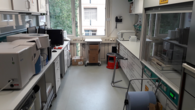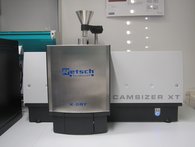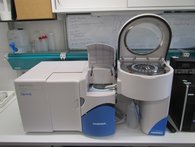
We have a fully equipped laboratory to process the sediment samples with two work spaces for sample preparation and two computer work spaces for analytical analysis and evaluation. The lab is outfitted with all equipment to chemically and physically prepare sediments for the analysis. We have shaking tables, a fume hot and large drying cupboard space designed for the fast the fast throughput of large sample batches such as for example daily resolved times series of suspended sediments or sediment cores.

Particle Analyzer CamsizerXT
In the SedLab we a Retsch CamsizerXT to analyse the the size distribution and shapes of sediments. The device uses high speed dynamic image analysis to measure in real-time the real size and shape of several million grains. Two high definition cameras are taking pictures of the projected shadows of each grain that is analysed. The software instantly calculates the grain size distribution and computes several shape parameters. We have two modules to disperse the grains for analysis one is a free-fall chute and the second is an air pressured accelerated chute that separates particles and aggregates. The measurement range of this device is between 10 μm and 3 cm. Due to the optical resolution limits the measuring range of the Camsizer can not cover clays very well and is more suited for coarser granulometries.

Laser Diffraction Particle Size Analyzer LA950
In the SedLab we have a Retsch/Horiba LA950 laser based particle size distribution analyser that uses the static scattering of laser light beams by particles of different sizes. The basic physical principle is the Fraunhofer Theory after which the intensity of scattered light is depending on the particle size. A second theory describing the scattering of electromagnetic waves on spherical objects is the Mie Theory. The later one is better suited for the interpretation of fine particles. Both models are automatically implemented in the measuring routing of our device. The advantages of static light scattering are that only a small amount of sample is needed for measuring a wide grain size range. In the SedLab we can measure grains in the size range of between 100 nm to about 3 cm. Our device is equipped with an auto sampler that allows us to run large batches of sediments and make efficient use of the machine and maximise the throughput of samples.

